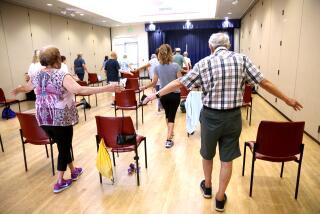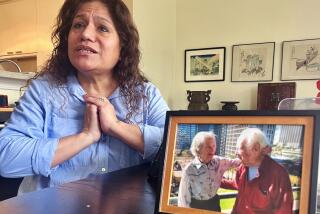For Seniors : His Longevity Theory Is Food for Thought
Never mind that the calendar says he’s 70. Roy Walford says he expects to live another 50 years--and that’s not based on hope or prayer.
It’s based on the results of his own scientific research that, simply stated, says: Eat a low-calorie, nutrient-rich diet; live longer and healthier.
Walford studied at Caltech and the University of Chicago Medical School. He is currently a professor of pathology at the UCLA School of Medicine (complete with his own research laboratory). He is the author of more than 250 scientific articles and four books and a member of the National Academy of Sciences and was the physician for Biosphere 2--a two-year experiment in which eight people lived and worked in a self-contained mini-world.
He has been interested in longevity since he was an adolescent. “There are so many things to do and I want to live longer to do them,” he said from his loft in Venice.
His home is decorated with hanging beads, a necklace of bones, faux parrots and flowers. There are souvenirs from his trip to India. (He went in order to measure the body temperatures of yogis.) There’s a mask from his hitchhiking trek across Africa. Most of the wall space is covered with exotic fabrics, swords, rugs, blown-up photos of him as a younger man, a poster from his guerrilla theater days in Paris and various paintings and photos of nudes--some of which he took.
There are a few otherworldly pictures taken inside Biosphere 2 (Biosphere 1 is the Earth). One is “Hunger,” with a nude Walford striking a Samuel Beckett-like pose, his mouth opened in a yearning expression as he holds two empty bowls at the entrance to the kitchen. The kitchen door has a large padlock on it as if to say “Closed.”
Food, but not much of it, is what Walford sees as the key to long life, mental clarity and sound health. Exercise is important, but to all of those who have been jumping, running, stepping and jogging all of these years, he has this to say: You’re not going to live longer, in spite of all the miles you’ve traveled to nowhere.
Until Biosphere 2, all of Walford’s experiments on longevity were done on animals. Experiments found that older mice, on a low-calorie diet, not only outlived their well-fed companions but performed physically strenuous tasks as well as younger mice.
Biosphere 2 was conceived as a massive, enclosed ecological space in the Arizona desert housing 3,800 species of plants and animals, as well as a rain forest and a 24,000-square-foot crop-growing area.
Walford, the physician for a team of three men and four women, entered this living laboratory amid rumors of an ecological cult and debate about the scientific relevance of the project. He said he did it for adventure and the experience, which he said helped prove his theories on low-calorie diets.
“We found that we could only grow food enough to provide each Biospherian with about 1,800 calories per day of quality food instead of 2,800. People were losing weight rapidly but, because of my background, I knew there was no reason to panic as long as the food we ate was nutrient-rich. We decided to continue,” he said.
Walford found similar changes in Biospherians on a low-calorie diet as he had with the animals: After six months the average weight of men decreased 26 pounds and of women, 15 pounds. Cholesterol levels dropped from an average level of 191 to 125. Blood pressure levels dropped from an average of 110/75 to 90/58 after only three months.
The team had vitality and showed high resistance to disease. His entire Biosphere experience is captured in his latest book, “The Anti-Aging Plan,” which includes a section on recipes written by his daughter, Lisa--an accomplished chef.
Walford’s research, after 20 years, is not without its critics. There is not enough evidence on humans to prove Walford’s theory. But it has aroused enthusiasm in the field of gerontology, the study of the aging process. The National Institute on Aging agreed in 1990 that it was worth a $3-million investment to find out more about the relationship between low-calorie intake and longevity.
This year, Walford is the keynote speaker at the Gerontological Society of America’s conference. And he has a list of speaking commitments until the end of the year.
“But,” Walford said, “I’m going to be very selective about my time in 1995 because I’m changing careers. I’m giving up UCLA and I’m going into computers and learning video techniques in greater depth.”
This is part of Walford’s plan for the rest of his life. To live into the 21st Century, he contends, people will have to re-educate themselves even if it means going back to school.
“We’re all going to have to do it in order to get retooled for the future and to prepare to live longer. Maybe we need to compress high school and college into a new kind of three-year, inter-generational institution where people would learn new careers,” he said.
Walford’s new career is in the arts. He has teamed with artist Barbara T. Smith on a show combining videotape he shot inside the Biosphere with her work that will interact in an exhibit titled “The 21st-Century Odyssey.”
He continues to study the effect of low-caloric intake on the Biosphere alumni and will go back on the regimen Sept. 26.
Recently, two of the team members married and Walford wrote this poem for them:
His heart leaped up when he beheld her in the IAB (Intensive Agriculture Biome)
A woman beautiful, great-spirited and fat-free .
While she, admiring the steadfastness of his mien,
Found strength to outlast the oppressors’ reign.
Two years of unremitting stress, of hothouse labor
Extinguished not the glow of their ardor
But fanned it to a flame by whose light we perceived
Our small world would finally be well. We received ,
In short, this ecological lesson: put to the test,
Of all that grows, Love grows best.






